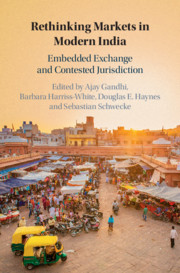Book contents
- Rethinking Markets in Modern India
- Rethinking Markets in Modern India
- Copyright page
- Contents
- Figures
- Tables
- Contributors
- 1 Markets in Modern India: Embedded, Contested, Pliable
- 2 Banking in the Bazaar: The Nattukottai Chettiars
- 3 Space in Motion: An Uneven Narrative of Urban Private Property in Bombay
- 4 Magic of Business: Occult Forces in the Bazaar Economy
- 5 Vernacular Capitalism, Advertising, and the Bazaar in Early Twentieth-Century Western India
- 6 The Artifice of Trust: Reputational and Procedural Registers of Trust in North Indian “Informal” Finance
- 7 Mandi Acts and Market Lore: Regulatory Life in India’s Agricultural Markets
- 8 The Market and the Sovereign: Politics, Performance, and Impasses of Cross-LOC Trade
- 9 Brandism vs. Bazaarism: Mediating Divinity in Banaras
- 10 Black Money in India: Fighting Specters and Fostering Relations
- 11 Market Making in Punjab Lotteries: Regulation and Mutual Dependence
- 12 Liquid Assets: Transactional Grammars of Alcohol in Jharkhand
- 13 Building on Sand? Criminal Markets and Politics in Tamil Nadu
- Index
- References
2 - Banking in the Bazaar: The Nattukottai Chettiars
Published online by Cambridge University Press: 24 September 2020
- Rethinking Markets in Modern India
- Rethinking Markets in Modern India
- Copyright page
- Contents
- Figures
- Tables
- Contributors
- 1 Markets in Modern India: Embedded, Contested, Pliable
- 2 Banking in the Bazaar: The Nattukottai Chettiars
- 3 Space in Motion: An Uneven Narrative of Urban Private Property in Bombay
- 4 Magic of Business: Occult Forces in the Bazaar Economy
- 5 Vernacular Capitalism, Advertising, and the Bazaar in Early Twentieth-Century Western India
- 6 The Artifice of Trust: Reputational and Procedural Registers of Trust in North Indian “Informal” Finance
- 7 Mandi Acts and Market Lore: Regulatory Life in India’s Agricultural Markets
- 8 The Market and the Sovereign: Politics, Performance, and Impasses of Cross-LOC Trade
- 9 Brandism vs. Bazaarism: Mediating Divinity in Banaras
- 10 Black Money in India: Fighting Specters and Fostering Relations
- 11 Market Making in Punjab Lotteries: Regulation and Mutual Dependence
- 12 Liquid Assets: Transactional Grammars of Alcohol in Jharkhand
- 13 Building on Sand? Criminal Markets and Politics in Tamil Nadu
- Index
- References
Summary
Under colonial rule, the Nattukottai Chettiar or Nakarattar caste organized themselves into a complex, segmentary network of interdependent family merchant-banking firms. Each firm traded individually in commodities trading, money lending, domestic and overseas banking operations, or industrial investment. But beyond this - making possible every other commercial venture in which it engaged - each family firm operated as a commercial bank: taking money on deposit and drafting hundis and other financial instruments for use in the transfer of loanable capital to branch offices and to other banks. As a result, every Nakarattar firm was tied together with all of the others to form a unified banking system, playing a major role in the credit markets of South Asia and the Indian Ocean rim.
- Type
- Chapter
- Information
- Rethinking Markets in Modern IndiaEmbedded Exchange and Contested Jurisdiction, pp. 29 - 53Publisher: Cambridge University PressPrint publication year: 2020

